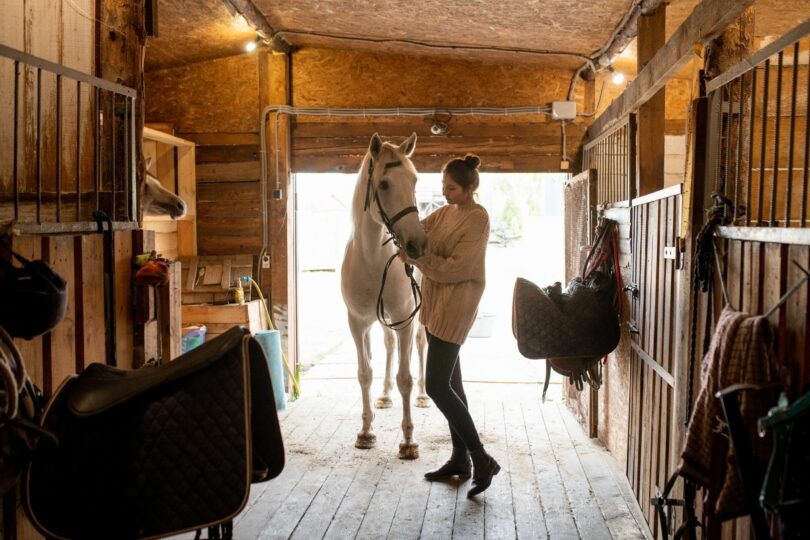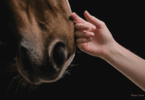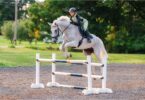Learn the lingo. Talk like a pro.
The horse world can feel overwhelming to those who are just getting started. There seems to be special terminology for everything from equipment to riders to veterinary terms when it comes to horse care. How should new equestrians know where to start?
This article will help those new to the world of horses better understand some common horse care terms. Learn the lingo so you can confidently “talk the talk” with other equestrians.
Stable Terms
These are all words equestrians use to describe objects, tasks, and people relating to horse barns. For the record, a stable is the name of the building where horses are kept and cared for; it is interchangeable with the word barn.
Mucking Out
If someone says they are mucking out a stall, they are describing the act of cleaning up horse excrement. This task usually involves using a pitchfork to remove dirty stall bedding and placing it in a wheelbarrow or other disposal container.
Once the dirty bedding is removed, you can then add new, clean, bedding in its place.
Horses are usually moved to another stall or brought outside while their caretaker cleans the stall.
Stall
The square box within a stable where a horse is kept. Each horse that lives in a stable should have their own stall. Stalls should provide shelter from the elements and be dry and well ventilated.
They may contain hay nets or mangers, feed buckets, and water buckets.
Stall floors are generally covered with shavings or another form of bedding. Some stalls may use heavy duty rubber mats to both protect and provide cushioning for the horse against the ground.
Cross Ties
These are sets of two ropes or straps that are set up in a barn aisle or within a wash rack. Cross ties secure the horse from either side, attaching to the halter. This method of restraint is more secure than tying a horse with a lead rope.
Once in cross ties, the owner or handler can groom and tack up the horse.
Generally, the snap end is connected to the halter, and the quick-release end is connected to the wall. In the event the horse spooks or needs to be untied quickly, you can safely release the wall-end and still have a length of rope or strap to grab a loose horse.
Wash Room
The wash room or wash rack area is for horse bathing and/or grooming. It usually has rubber or other non-slip flooring and a place to either tie or cross tie your horse. Wash racks have a hose with a nozzle to make washing easier.
Always clean up after your horse in the wash rack so it is ready to go for the next person!
Tack
This is the general term for any and all horse equipment. Tack includes saddles, bridles, saddle pads, leg wraps, ear bonnets, blankets and more. Anything you are able to put on a horse can be considered tack.
Tack is generally stored in a tack room or a tack box.

Photo Cred: Canva
Farrier
The equine professional that cares for your horse’s hooves is called a farrier. Farriers usually see horses every 6-8 weeks to trim your horse’s hooves and put shoes on, if requested.
Farriers may be discipline specific, or have certain specialties.
Round Pen
A circular enclosure used for exercising horses. Round pens are generally 50-60 feet in diameter and are constructed from steel livestock panels or wooden fencing.
Sometimes they are fully enclosed so the horse cannot see outside of it.
Round pens are primarily used for longing and training horses.
Turnout Terms
Equestrians say a horse is in turnout any time they are not in their stall or being ridden. Turnout can be described as free choice, unstructured exercise in a larger area.
Turnout can be on dirt (a “dry” paddock, or grass “pasture” and can be solo or in groups. If horses are turned out in groups, they are generally gender specific.
Paddock
A small, fenced in area near the stable when horses can be brought to graze, be exercised, or be tacked up. Paddocks are generally dirt and may be called a dry lot.
Pasture
A large, fenced in field where horses can graze. Size may be dependent on the number of horses using the space. Pastures are generally grassy and need to be managed for optimal grazing.
Poisonous weeds should be removed, and horses may need to be rotated as to not over-graze an area.

Photo Cred: Canva
Halter
A halter is a piece of tack that fits around the horse’s nose, ears, and chin. The halter is used to lead horses by attaching a lead rope to the ring on the chin.
Halters come in pony, horse, and cob (draft horse) sizes to fit any horse. They can be made from leather, nylon, or rope.
Feeding Terms
Nutrition is one of the most important parts of caring for a horse. Horses have five main nutrients that are essential in their diets: carbohydrates, protein, fat, vitamins, and minerals. They also need plenty of water. Horses should eat around 2% of their body weight everyday.
Alfalfa Hay
Alfalfa is a type of hay that is generally considered to be higher quality and richer than grass hay. It differs from grass hay in that it has higher protein and calcium levels. Alfalfa may be greener in color than grass hay, and will likely have small leaves in it. Hay is a forage and should make up the bulk of a horse’s diet.
Grass Hay
Grass hay is a type of hay that can be fed to horses or other livestock. It is generally lower in protein and calcium levels than alfalfa hay. Grass hay should be just that—stems of grass, whereas alfalfa hay has small leaves (think of dried clover). Always inspect hay for mold; never feed moldy hay to a horse.
Grain
While a horse’s diet should be mostly roughage (hay), it is often supplemented with a grain of the owner’s choosing. Typical grains fed to horses include oats, corn, barley, and wheat.
Grains provide extra energy to a horse and are especially important for horses in heavy exercise or mares that are lactating.
Supplements
Supplements are concentrated substances that typically target a specific dietary concern. They can be fed in powdered, granulated, or pelleted form and are generally given as a top-dress with grain.
Common supplements used by horse owners include joint support supplements, supplements for colic prevention, and supplements for weight gain.
Hay Net
A hay net is pretty straightforward—it’s a net that holds your horse’s hay! It can be used as a tool to encourage horses to eat their hay more slowly.
This can both help combat boredom and stretch out feed over a longer period of time, more naturally mimicking the horse’s natural grazing behavior. Always be sure to tie hay nets high enough that your horse can’t get a leg caught in them—they can be a safety hazard!
Grooming Terms
Regular grooming helps keep your horse’s coat, mane, tail, and hooves healthy. There are a variety of tools used for horse grooming that have unique names. It is important that you get to know them and their purposes.
Grooming is also a wonderful way to bond with your horse.
Curry Comb
A rubber or plastic brush with short, pointy teeth that is used to lift dirt, dead skin, and other grime up from the horse’s coat. It is used by moving it in circular motions across the coat. Only use a curry on the horse’s body, not on the lower legs or face.
Hoof Pick
A handheld tool used to clean out dirt, rocks, and other debris from the horse’s hooves. It has a metal hook used to scrape and lift the dirt up from the hooves, and a stiff brush to brush the lifted dirt away and bring up additional dirt. To use a hoof pick, gently guide the hook around the shape of the horse’s hoof, being careful to avoid the frog.
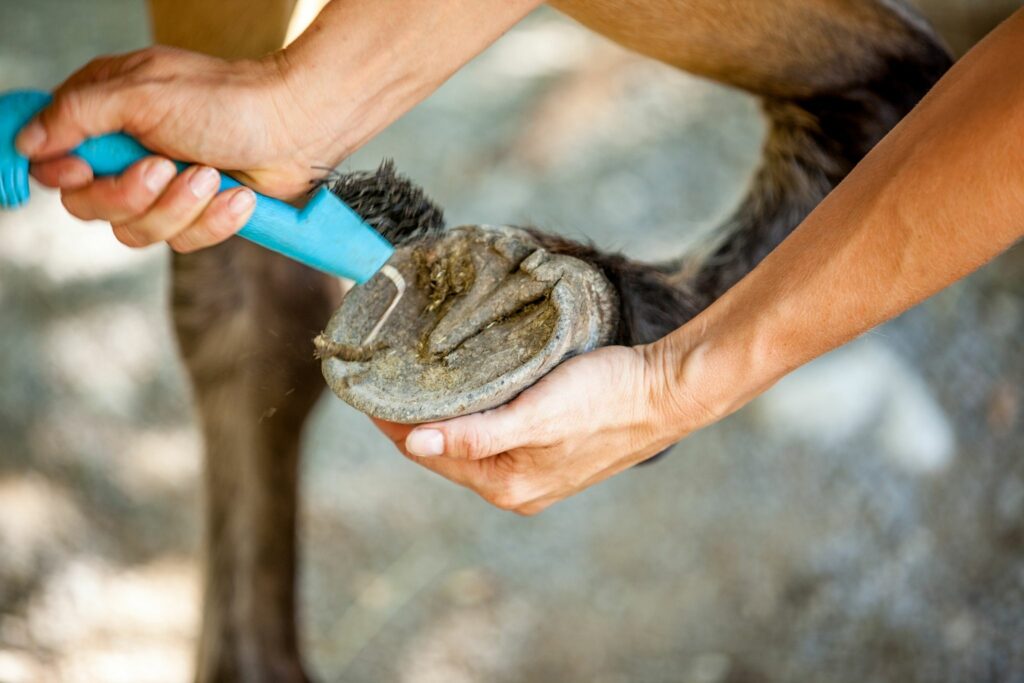
Photo Cred: Canva
Sweat Scraper
This is a handheld tool, similar to a squeegee, used to wick away water from a horse’s coat after bathing. To use, gently press it against the horse’s coat in the direction of the hair growth.
Sweat scrapers help dry the horse off faster. You can follow up with towel-drying or let the horse air dry.
Horse Groom
Grooms are hired hands that care for and groom the horse, as well as groom horses for the show ring and other special events.
They form bonds with the horses they care for, so they can easily spot changes in behavior that may indicate discomfort. Grooms can be responsible for much more than grooming, including feeding, tacking up, and even exercising horses.
Equine Health Terms
To better communicate with and understand your vet and other professionals involved with your horse’s medical care, it is important to understand some common equine health terms. The more you know, the better you will be able to advocate for your horse.
Lame
Lame means limping, although sometimes lameness is very subtle and not noticeable to the untrained eye. A horse is said to be lame whenever their gait is abnormal. They can go lame because of pain or stiffness in their legs.
Lameness is diagnosed through a lameness exam that looks at the horse’s history, standing posture, movement in walk and trot, joint flexion and hooves. To fully diagnose lameness, a veterinary exam may also include nerve blocks and x-rays.
Sound
Soundness is the opposite of lameness. A horse is considered sound when their gaits are normal.
Hand walk
Hand walking is when the horse is exercised at a walk from the ground. Hand walking can be used to cool a hot horse down, exercise an injured horse that needs to keep its movement restricted, and can also be used to prevent a horse that is colicing from rolling.
Cold Hose
Cold hosing is a treatment strategy for leg injuries. It is used to bring down swelling and inflammation and relieve pain. To cold hose properly, run cold water over the injured area for at least 20 minutes.
Liniment
Liniment is an ointment used to reduce swelling and inflammation, relieve pain, treat skin and hoof conditions, relieve soreness, and help with arthritis. To use, liberally spray over affected areas as needed.
Poultice
A poultice can be made from a variety of soft materials (usually clay-based) that are used to help heal an injury. The clay helps to hold the moisture in the mixture. They can be cold or warm and used on anything from sore areas to abscesses.
Most commonly, poultices are used on the lower leg in combination with standing wraps.
Colic
Colic is a general term for abdominal pain in horses. Horses cannot throw up, which can cause intestinal distress. There are many types and causes of colic. If left untreated, colic can be fatal.
Symptoms of colic include: looking or biting at the abdomen, frequent rolling or lying down, unable to pass manure, and disinterest in eating or drinking.
Stocked Up
A horse is considered to be “stocked up” when their lower leg is swollen. This is generally caused by lack of circulation or movement. Stocking up can occur more frequently in older horses. Increased movement can help eliminate this puffiness.
Teeth Floating
Floating is a necessary part of equine dental care. As the horse chews, their teeth wear, sometimes unevenly. Floating is the process of filing down any sharp or uneven points on the teeth.
Your vet can recommend the proper schedule for this procedure (annual, biannual, etc). The horse should be sedated for this.
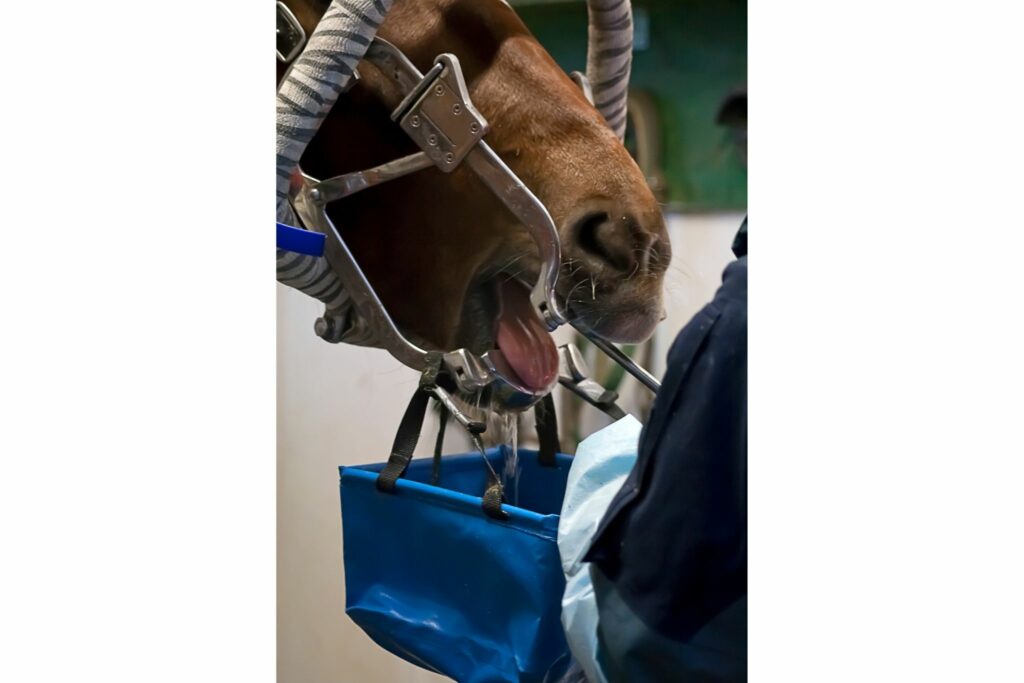
Photo Cred: Canva
Thrush
A bacterial or fungal infection of the frog of the horse’s foot generally caused by excess moisture in the horse’s environment. It is often diagnosed by the unpleasant smell that comes from the frog.
To treat, clean out the infected area and keep the horse in a cool, dry area. There are many over-the-counter medications to combat this issue. Thrush can be prevented with regular hoof care and stall management.
General Terms
These are terms you will hear when talking to horse people that are used to describe the activities they do with their horses
Horsemanship
Horsemanship is the “art of riding, handling, and training horses.” The best horsemen/horsewomen communicate with their horses effectively with minimal effort. Horsemanship takes time and hands-on experience.
Groundwork
Training and working with a horse from the ground. This could include longing, grooming, leading, and showmanship. Good groundwork is the foundation to a good relationship under saddle.
English Riding
One of the two main styles of riding. English ring disciplines include dressage, showjumping, hunter/jumper, and eventing. Tack, riding attire, and gait terminology differs from that of western riding.
Western Riding
The other main style of riding. Western disciplines include barrel racing, team roping, reining, western pleasure, and trail. Tack, riding attire, and gait terminology differs from that of english riding.
Hunt Seat
An English riding discipline where the horse and rider are judged on their unique ability and style over jumps and on the flat
Frequently Asked Questions
Q: What is sitting on a horse called?
Sitting on a horse is called horseback riding. The process of getting on a horse’s back is called mounting.
Q: What do you call working a horse on a circular track?
Longing. It is where the horse is connected to a longe line by their halter or bridle and is asked to move in a circular track around the handler. The purpose of longing is for exercise. Longing can be the exercise, or it can be used as a warm-up to help a horse release pent up energy so that they are relaxed and supple under saddle.
Parting Thoughts
Working with horses is both an art and a science. There are a lot of terms specific to the industry that are important to know. The more terms you are familiar with, the better you can communicate with other professionals, and non-professionals, in the industry.
P.S. Enjoy this article? Trot on over to:
- Horse care 101: Turnout blankets vs. stable blankets
- Horse Riding Equipment List: What You Need & What You Don’t
- Horse Care for the Total Beginner – You CAN Do This!
- Down ‘n Dirty Horse Barn Cleaning Tips
- Beginner’s Guide to Horse Hay Nets & Bags
- Horse Riding Gear for Beginners (Quick Print Equipment List)
- The Ultimate Packing & Horse Trailering Checklist
- What Gear Do You Need to Ride Horses as an Adult
- 99 Fun & Incredible Horse Facts for Kids
Sources
https://www.equisearch.com/articles/crosstie-training-your-horse#:~:text=A%20traditional%20crosstie%20setup%20has,in%20place%20by%20two%20lines
https://horsekingstore.com/en/blog/the-halter-history-use-and-maintenance-n1\
https://extension.uga.edu/publications/detail.html?number=B1355&title=How%20to%20Feed%20a%20Horse:%20Understanding%20the%20Basic%20Principles%20of%20Horse%20Nutrition
https://alfalfa.ucdavis.edu/+symposium/proceedings/2001/01-061.pdf
https://horseracingsense.com/alfalfa-hay-for-horses-good-bad-and-not-good/
https://extension.psu.edu/the-scoop-on-grains-and-concentrates#:~:text=The%20most%20common%20are%20oats,typically%20processed%20to%20increase%20digestibility
https://irishvetjournal.biomedcentral.com/articles/10.1186/s13620-018-0115-3
https://blog.smartpakequine.com/2017/12/horse-grooming-tools-guide/
https://aaep.org/horsehealth/understanding-lameness
https://www.thesprucepets.com/how-to-cold-hose-1886845#:~:text=Cold%20hosing%20is%20simple%2C%20as,for%20that%20length%20of%20time
https://horserookie.com/why-use-horse-liniment/
https://www.horsehealthproducts.com/horsemans-report/hoof-leg-care/liniments-or-poultices-whats-the-difference
https://extension.umn.edu/horse-health/colic-your-horse#types-of-colic–71561
https://www.thesprucepets.com/stocked-up-legs-in-horses-1885853
https://templebeltonfeed.com/blog/59816/when-should-i-have-my-horse-s-teeth-floated#:~:text=In%20general%2C%20younger%20horses%20less,need%20treatment%20even%20that%20frequently.
https://vcahospitals.com/know-your-pet/thrush-in-horses#:~:text=Thrush%20is%20an%20infection%20of,bacterial%20infection%2C%20occasionally%20fungal%20infection
https://horsemanship-journal.com/articles/what-horsemanship
https://missourihorseshowsassociation.org/riding-styles/

